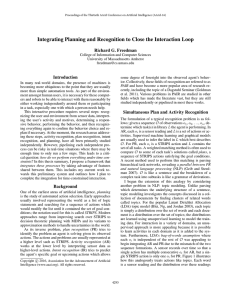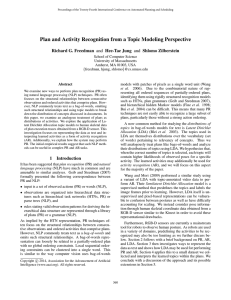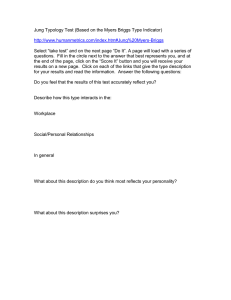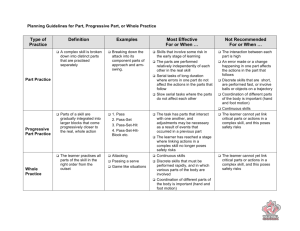Temporal and Object Relations in Plan and
advertisement
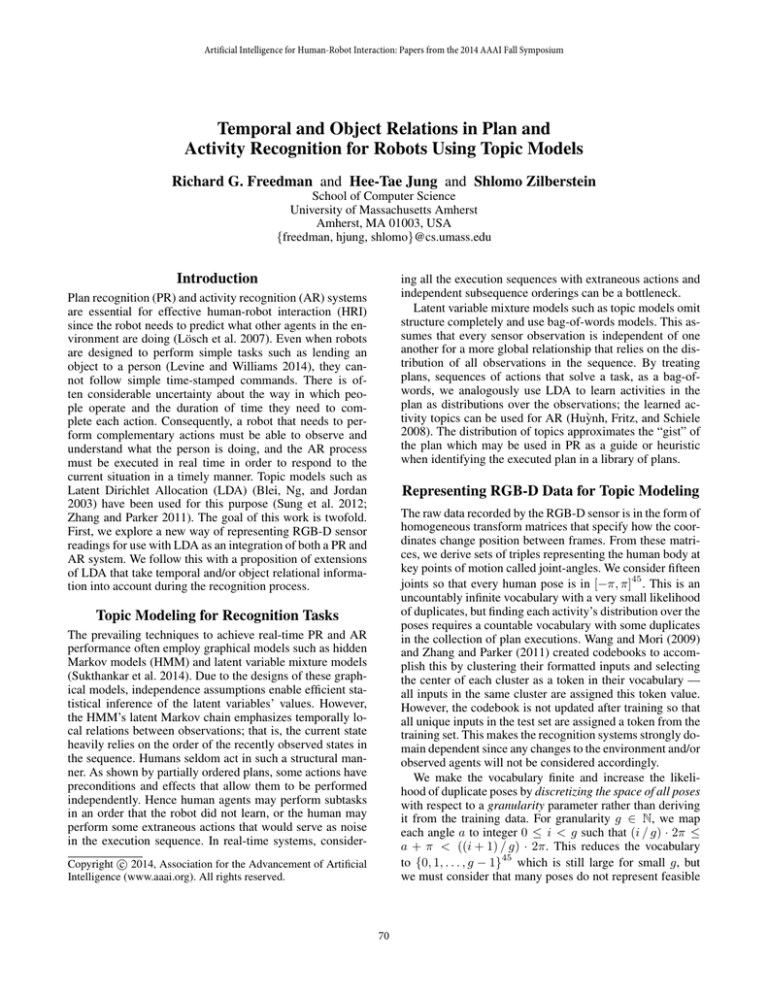
Artificial Intelligence for Human-Robot Interaction: Papers from the 2014 AAAI Fall Symposium
Temporal and Object Relations in Plan and
Activity Recognition for Robots Using Topic Models
Richard G. Freedman and Hee-Tae Jung and Shlomo Zilberstein
School of Computer Science
University of Massachusetts Amherst
Amherst, MA 01003, USA
{freedman, hjung, shlomo}@cs.umass.edu
Introduction
ing all the execution sequences with extraneous actions and
independent subsequence orderings can be a bottleneck.
Latent variable mixture models such as topic models omit
structure completely and use bag-of-words models. This assumes that every sensor observation is independent of one
another for a more global relationship that relies on the distribution of all observations in the sequence. By treating
plans, sequences of actions that solve a task, as a bag-ofwords, we analogously use LDA to learn activities in the
plan as distributions over the observations; the learned activity topics can be used for AR (Huỳnh, Fritz, and Schiele
2008). The distribution of topics approximates the “gist” of
the plan which may be used in PR as a guide or heuristic
when identifying the executed plan in a library of plans.
Plan recognition (PR) and activity recognition (AR) systems
are essential for effective human-robot interaction (HRI)
since the robot needs to predict what other agents in the environment are doing (Lösch et al. 2007). Even when robots
are designed to perform simple tasks such as lending an
object to a person (Levine and Williams 2014), they cannot follow simple time-stamped commands. There is often considerable uncertainty about the way in which people operate and the duration of time they need to complete each action. Consequently, a robot that needs to perform complementary actions must be able to observe and
understand what the person is doing, and the AR process
must be executed in real time in order to respond to the
current situation in a timely manner. Topic models such as
Latent Dirichlet Allocation (LDA) (Blei, Ng, and Jordan
2003) have been used for this purpose (Sung et al. 2012;
Zhang and Parker 2011). The goal of this work is twofold.
First, we explore a new way of representing RGB-D sensor
readings for use with LDA as an integration of both a PR and
AR system. We follow this with a proposition of extensions
of LDA that take temporal and/or object relational information into account during the recognition process.
Representing RGB-D Data for Topic Modeling
The raw data recorded by the RGB-D sensor is in the form of
homogeneous transform matrices that specify how the coordinates change position between frames. From these matrices, we derive sets of triples representing the human body at
key points of motion called joint-angles. We consider fifteen
45
joints so that every human pose is in [−π, π] . This is an
uncountably infinite vocabulary with a very small likelihood
of duplicates, but finding each activity’s distribution over the
poses requires a countable vocabulary with some duplicates
in the collection of plan executions. Wang and Mori (2009)
and Zhang and Parker (2011) created codebooks to accomplish this by clustering their formatted inputs and selecting
the center of each cluster as a token in their vocabulary —
all inputs in the same cluster are assigned this token value.
However, the codebook is not updated after training so that
all unique inputs in the test set are assigned a token from the
training set. This makes the recognition systems strongly domain dependent since any changes to the environment and/or
observed agents will not be considered accordingly.
We make the vocabulary finite and increase the likelihood of duplicate poses by discretizing the space of all poses
with respect to a granularity parameter rather than deriving
it from the training data. For granularity g ∈ N, we map
each angle a to integer 0 ≤ i < g such that (i / g) · 2π ≤
a + π < ((i + 1) / g) · 2π. This reduces the vocabulary
45
to {0, 1, . . . , g − 1} which is still large for small g, but
we must consider that many poses do not represent feasible
Topic Modeling for Recognition Tasks
The prevailing techniques to achieve real-time PR and AR
performance often employ graphical models such as hidden
Markov models (HMM) and latent variable mixture models
(Sukthankar et al. 2014). Due to the designs of these graphical models, independence assumptions enable efficient statistical inference of the latent variables’ values. However,
the HMM’s latent Markov chain emphasizes temporally local relations between observations; that is, the current state
heavily relies on the order of the recently observed states in
the sequence. Humans seldom act in such a structural manner. As shown by partially ordered plans, some actions have
preconditions and effects that allow them to be performed
independently. Hence human agents may perform subtasks
in an order that the robot did not learn, or the human may
perform some extraneous actions that would serve as noise
in the execution sequence. In real-time systems, considerc 2014, Association for the Advancement of Artificial
Copyright Intelligence (www.aaai.org). All rights reserved.
70
Figure 2: Graphical model representation of the parameterized
composite model. The dotted lines represent conditional dependencies between random variables that are not visible due to the plate
notation used.
Figure 1: Most likely poses for topic ten from the fifteen-topic
model at granularity thirty-five. The poses appear to be walking.
semantics into account. We believe that the composite model
may also be used for sequences of observations to bring together both temporally local and global relationships for improved PR and AR. The extensions of LDA for the composite model are blue in the graphical model of Figure 2.
Besides the lack of temporal information, we found that
actions with similar poses such as squatting and jumping
were clustered together since their inputs are indistinguishable (Freedman, Jung, and Zilberstein 2014). This can be
attributed to a lack of environmental information such as
nearby objects — squatting poses are closer to the ground
than jumping poses. Another reason for including relations
between observed users and objects in the environment is
that the robot’s interactions with the user will likely involve
handling the same objects. For example, in joint tasks such
as moving furniture (Mörtl et al. 2012), both agents will need
to handle the same furniture object in order to coordinate
carrying it. The generalized use of objects has also been addressed in the field of robotics under tool affordance (Gibson
2001; Jain and Inamura 2013; Jung, Ou, and Grupen 2010).
We presently consider grounded object instances as parameters for a token. That is, a single word in a sequence is now
a K-ary proposition of the form wi pi,1 , . . . , pi,Kwi where
Kw is the arity of word token w. We assume that these arguments are elements of a second vocabulary representing
only the objects. Our extension of LDA for these parameterizations are colored red in the graphical model of Figure 2.
body postures. An advantage of discretizing the space over
the use of a codebook is that it is possible to encounter new
poses for which the system was not trained. This is important
for domain independent HRI applications where PR and AR
will be used to observe a constantly changing set of users.
While larger granularities clearly reduce the number of
duplicate poses, another interesting factor to consider is its
parity (Freedman, Jung, and Zilberstein 2014). This phenomenon may be explained through kinematics. When an
even granularity is used to discretize the space, small joint
movements near the vertical axis (where a = 0) will be assigned to one of two different groups: (g / 2) if a ≥ 0 and
(g / 2) − 1 if a < 0. On the other hand, an odd granularity will always assign these movements to ((g − 1) / 2). For
naturally small body movements and oscillations about the
vertical axis such as an arm swaying slightly at the user’s
side, the mapping between two groups rather than one creates significantly more combinations for even granularities
compared to odd ones. Figure 1 shows a sample interpretable
topic produced using granularity thirty-five.
Incorporating Temporal and Object Relations
While the proposed use of LDA has shown empirical success in learning activities whose poses represent distinct actions (Freedman, Jung, and Zilberstein 2014), there are still
issues which must be addressed to improve the performance
of the integrated PR and AR system. The more evident concern arises from the bag-of-words model’s independence assumption. Without any dependence on ordering, activities
with cyclic structure are hard to recognize unless each iteration has a proportional contribution of observations to the
global distribution, and there is clearly some degree of correlation between consecutive poses due to continuous motion of the body. Similar concerns have been raised in natural language processing, an area suggested to have much in
common with plan recognition (Geib and Steedman 2007).
The local temporal dependencies enforced by HMM’s place
a strong emphasis on syntactic properties of phrases without
any consideration of semantics. The global dependencies enforced by LDA instead emphasize the semantic features of
text without acknowledging its syntax. The composite model
(Griffiths et al. 2004) was developed to bring HMM’s and
LDA together for a single model that takes both syntax and
Future Work
In addition to the new model proposed in this paper, there
are other variations of LDA which have been developed to
account for temporal information such as Topics over Time
(Wang and McCallum 2006) and n-gram tokens (Wallach
2006). We will investigate which is most appropriate for postural input. Furthermore, real-time constraints are crucial for
HRI and increasing model complexity will slow down the
performance. Porteous et al. (2008) have developed a sampling method to improve the runtime of LDA, and we intend
to extend their work for our models. Most importantly, we
plan to incorporate our integrated PR and AR framework
into an actual robot for testing in real environments with human subjects; it is necessary that our methods perform well
empirically in the motivating domain.
71
References
Wallach, H. M. 2006. Topic modeling: Beyond bag-ofwords. In Proceedings of the 23rd International Conference
on Machine Learning, 977–984.
Wang, X., and McCallum, A. 2006. Topics over time: A
non-Markov continuous-time model of topical trends. In
Proceedings of the 12th ACM SIGKDD International Conference on Knowledge Discovery and Data Mining, 424–
433.
Wang, Y., and Mori, G. 2009. Human action recognition
by semi-latent topic models. IEEE Transactions on Pattern
Analysis and Machine Intelligence Special Issue on Probabilistic Graphical Models in Computer Vision 31(10):1762–
1774.
Zhang, H., and Parker, L. 2011. 4-dimensional local
spatio-temporal features for human activity recognition. In
Proceedings of the International Conference on Intelligent
Robots and Systems, 2044–2049.
Blei, D. M.; Ng, A. Y.; and Jordan, M. I. 2003. Latent
Dirichlet allocation. Journal of Machine Learning Research
3:993–1022.
Freedman, R. G.; Jung, H.-T.; and Zilberstein, S. 2014. Plan
and activity recognition from a topic modeling perspective.
In Proceedings of the 24th International Conference on Automated Planning and Scheduling.
Geib, C. W., and Steedman, M. 2007. On natural language processing and plan recognition. In Proceedings of
the 20th International Joint Conference on Artificial Intelligence, 1612–1617.
Gibson, E. 2001. Perceiving the Affordances: A Portrait of
Two Psychologists. Taylor & Francis.
Griffiths, T. L.; Steyvers, M.; Blei, D. M.; and Tenenbaum,
J. B. 2004. Integrating topics and syntax. In Advances in
Neural Information Processing 17, 537–544.
Huỳnh, T.; Fritz, M.; and Schiele, B. 2008. Discovery of activity patterns using topic models. In Proceedings of the 10th
International Conference on Ubiquitous Computing, 10–19.
Jain, R., and Inamura, T. 2013. Bayesian learning of tool
affordances based on generalization of functional feature to
estimate effects of unseen tools. Artificial Life and Robotics
18(1-2):95–103.
Jung, H.; Ou, S.; and Grupen, R. A. 2010. Learning to perceive human intention and assist in a situated context. In
Workshop on Learning for Human-Robot Interaction Modeling, Robotics: Science and Systems.
Levine, S. J., and Williams, B. C. 2014. Concurrent plan
recognition and execution for human-robot teams. In Proceedings of the 24th International Conference on Automated
Planning and Scheduling.
Lösch, M.; Schmidt-Rohr, S.; Knoop, S.; Vacek, S.; and
Dillmann, R. 2007. Feature set selection and optimal classifier for human activity recognition. In Proceedings of
the16th International Symposium on Robot and Human interactive Communication, 1022–1027.
Mörtl, A.; Lawitzky, M.; Kucukyilmaz, A.; Sezgin, M.; Basdogan, C.; and Hirche, S. 2012. The role of roles: Physical
cooperation between humans and robots. International Journal of Robotics Research 31(13):1656–1674.
Porteous, I.; Newman, D.; Ihler, A.; Asuncion, A.; Smyth,
P.; and Welling, M. 2008. Fast collapsed gibbs sampling for
latent dirichlet allocation. In Proceedings of the 14th ACM
SIGKDD International Conference on Knowledge Discovery and Data Mining, KDD ’08, 569–577. New York, NY,
USA: ACM.
Sukthankar, G.; Geib, C.; Bui, H. H.; Pynadath, D.; and
Goldman, R. P. 2014. Plan, Activity, and Intent Recognition: Theory and Practice. Elsevier Science.
Sung, J.; Ponce, C.; Selman, B.; and Saxena, A. 2012.
Unstructured human activity detection from RGBD images.
In Proceedings of the IEEE International Conference on
Robotics and Automation, 842–849.
72




